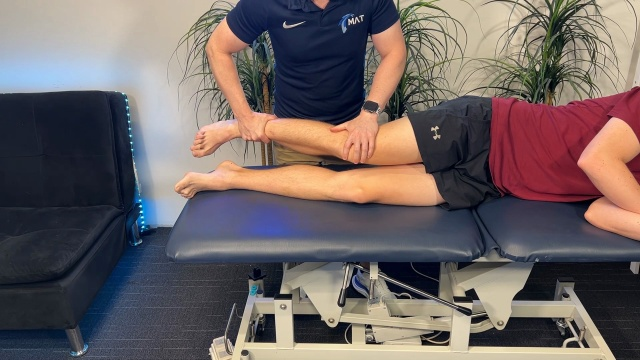Slocum's test
- Fysiobasen

- Sep 15
- 3 min read
Slocum’s Test is a clinical examination used to assess anteromedial (AMRI) and anterolateral rotational instability (ALRI) of the knee. The test was described in 1976 as a modified version of the classical anterior drawer test, which primarily evaluates the anterior cruciate ligament (ACL). By adding tibial rotation during the anterior drawer maneuver, Slocum’s Test allows for the evaluation of rotational instability resulting from ligament and capsular injuries. The test is useful for differentiating between different combinations of ligament injuries and for planning further treatment.

Advantages and Limitations
Slocum’s Test is easy to perform in a clinical setting and provides valuable information about rotational instability. It requires no advanced equipment and can quickly indicate the need for further evaluation or referral. However, it is a relatively crude test and can be influenced by patient muscle tension or pain during the procedure. Therefore, it should always be combined with other clinical examinations and patient history for a reliable assessment.
Clinically Relevant Anatomy
Anterolateral rotational instability (ALRI): often involves injury to the ACL, posterolateral capsule, arcuate-popliteus complex, lateral collateral ligament, and iliotibial band
Anteromedial rotational instability (AMRI): often involves injury to the ACL, medial collateral ligament, posterior oblique ligament, and posteromedial capsule
Knowledge of these anatomical structures is essential for correctly interpreting test results.
Execution
Testing for ALRI:
The patient lies supine with the knee flexed to 90° and the foot stabilized against the table
The tibia is rotated internally 30°
The examiner pulls the tibia forward as in the anterior drawer test while maintaining internal rotation
Increased anterior translation of the lateral tibial plateau or noticeable lateral rotation indicates ALRI
Testing for AMRI:
The patient lies supine with the knee flexed to 90° and the foot stabilized against the table
The tibia is rotated externally 15°
The examiner pulls the tibia forward and simultaneously assesses for excessive anterior and outward rotation of the medial tibial plateau
Excessive rotation suggests medial instability (AMRI)
Alternative method for ALRI:
The patient lies on the uninjured side with hip and knee flexed
The pelvis is rotated backward approximately 30° from supine, with the medial border of the foot resting on the table in full extension
This eliminates hip rotation, allows the knee to fall into valgus, and causes internal tibial rotation
The examiner places both hands on the lateral side of the knee while the patient gradually flexes the knee
With light valgus stress applied, subluxation may occur and then reduce as the knee flexes from 25° to 40°, indicating ALRI
Interpretation of Results
Positive ALRI: Increased anterior translation and rotation of the lateral tibial plateau during anterior pull with internal rotation → indicates lateral structural injury
Positive AMRI: Excessive anterior and external rotation of the medial tibial plateau during anterior pull with external rotation → indicates medial structural injury
Evidence Base and Clinical Relevance
Slocum’s Test has an evidence level of V (expert opinion and case reports). It is widely used in the evaluation of patients with ACL rupture in combination with injury to other stabilizing structures. Due to a lack of systematic studies, the test should always be interpreted together with other clinical findings and imaging when assessing rotational instability.
Summary
Slocum’s Test is a valuable modification of the anterior drawer test that helps identify rotational instabilities in the knee. By applying rotational stress during anterior translation, the test differentiates between anteromedial and anterolateral instability. Although evidence is limited, the test remains a useful clinical tool when combined with other assessments.
Sources.
Postsurgical orthopedic sports rehabilitation: knee and shoulder – Robert C Manske
Kaplan National Physical Therapy exam – Bethany Chapman, Mary Friatinni
Neuromusculoskeletal examination and assessment: a handbook for therapists – Nicola F Petty, Ann P Moore
Larson RL, Physical examination in the diagnosis of rotatory instability, clin orthop relat res, 1983, 172, 38-44
Donald B. Slocum, Robert L Larson. Rotatory Intability of the Knee: its pathogenesis and a clinical test to demonstrate its presence. The journal of Bone and Joint Surgery, american volume, 1968; 50-A, No.2:211-225.
J C Kennedy, F.R.C.S, Roger Stewart and Dennis M. Walker. Anterolateral rotatory instability of the knee joint: an early analysis of the elisson procedure, The journal of bone and joint surgery. 1978; Vol 60-A, No 8; 1031-1039.









